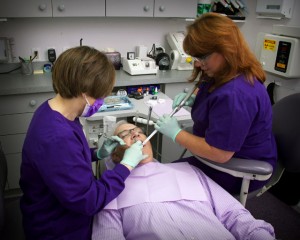Crowns (Caps)
Crowns are typically used to restore a tooth’s function and appearance following a restorative procedure such as a root canal. Also, when decay in a tooth has become advanced so that a large portion of the tooth must be removed, crowns are used to restore the tooth. Crowns are composed of porcelain with gold alloys, or porcelain alone. They are also used to attach bridges, cover implants and to protect a cracked tooth. Crowns also serve an aesthetic use, and are placed when a discolored or stained tooth needs to be restored to its natural appearance. We are placing many crowns made of all porcelain called e.max® crowns. They are made of a substance called lithium disilicate. They are 2-3 times stronger than the traditional porcelain-gold crown and have a more natural appearance.
Procedures
 A tooth must first be contoured to accommodate a crown. An impression is then made of the existing tooth to create a model. This impression is sent to a dental laboratory, which manufactures a custom-designed crown. In most cases, a temporary, or interim crown is placed on the tooth until the permanent crown is ready. Permanent crowns are cemented in place approximately 3 weeks later.
A tooth must first be contoured to accommodate a crown. An impression is then made of the existing tooth to create a model. This impression is sent to a dental laboratory, which manufactures a custom-designed crown. In most cases, a temporary, or interim crown is placed on the tooth until the permanent crown is ready. Permanent crowns are cemented in place approximately 3 weeks later.
Caring For Your Crowns
With proper care, a good quality crown may last a long time. It is very important to floss in the area of the crown to avoid excess plaque or collection of debris around the restoration. It is possible to get decay around/under a crown. Avoiding sugary foods and rinsing with a fluoride rinse is advised. Certain behaviors such as jaw clenching or bruxism (teeth grinding) significantly shorten the life of a crown. Moreover, eating brittle foods, ice or hard candy can damage the crown or compromise the adhesion of the crown
Bridges
Bridges are natural-looking dental restorations that are used to replace an area of one or more missing teeth. They are custom-made and restore the natural contour of the teeth as well as the proper bite relationship between the upper and lower teeth. Bridges are sometimes referred to as fixed partial dentures, because they are permanent and are bonded to existing teeth or implants; they cannot be removed. There are several types of bridges, including conventional fixed bridges, cantilever bridges and resin-bonded bridges. Bridges are fabricated out of porcelain, gold alloys or combinations of materials.